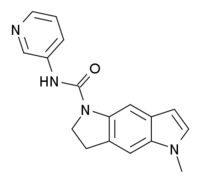SB-206,553
Prijeđi na navigaciju
Prijeđi na pretragu

| |||
| (IUPAC) ime | |||
|---|---|---|---|
| 5-metil-1-(3-piridilkarbamoil)-1,2,3,5-tetrahidropirolo[2,3-f]indol | |||
| Klinički podaci | |||
| Identifikatori | |||
| CAS broj | 158942-04-2 | ||
| ATC kod | nije dodeljen | ||
| PubChem[1][2] | 5163 | ||
| Hemijski podaci | |||
| Formula | C17H16N4O | ||
| Mol. masa | 292,334 g/mol | ||
| SMILES | eMolekuli & PubHem | ||
| |||
| Farmakoinformacioni podaci | |||
| Trudnoća | ? | ||
| Pravni status | |||
SB-206,553 je lek koji deluje kao mešoviti antagonist za 5-HT2B i 5-HT2C serotoninske receptore.[3][4][5] On ima anksiolitička svojstava u životinjskim studijama i formira interakcije sa nizom drugih lekova.[6][7][8][9][10][11][12][13][14] On takođe deluje kao pozitivni alosterni modulator α7 nikotinskih acetilholinskih receptora.[15]
Reference[uredi | uredi kod]
- ↑ Li Q, Cheng T, Wang Y, Bryant SH (2010). „PubChem as a public resource for drug discovery.”. Drug Discov Today 15 (23-24): 1052-7. DOI:10.1016/j.drudis.2010.10.003. PMID 20970519.
- ↑ Evan E. Bolton, Yanli Wang, Paul A. Thiessen, Stephen H. Bryant (2008). „Chapter 12 PubChem: Integrated Platform of Small Molecules and Biological Activities”. Annual Reports in Computational Chemistry 4: 217-241. DOI:10.1016/S1574-1400(08)00012-1.
- ↑ Forbes IT, Ham P, Booth DH, Martin RT, Thompson M, Baxter GS, Blackburn TP, Glen A, Kennett GA, Wood MD (July 1995). „5-Methyl-1-(3-pyridylcarbamoyl)-1,2,3,5-tetrahydropyrrolo[2,3-f]indole: a novel 5-HT2C/5-HT2B receptor antagonist with improved affinity, selectivity, and oral activity”. Journal of Medicinal Chemistry 38 (14): 2524–30. DOI:10.1021/jm00014a004. PMID 7629791.
- ↑ Kennett GA, Wood MD, Bright F, Cilia J, Piper DC, Gager T, Thomas D, Baxter GS, Forbes IT, Ham P, Blackburn TP (February 1996). „In vitro and in vivo profile of SB 206553, a potent 5-HT2C/5-HT2B receptor antagonist with anxiolytic-like properties”. British Journal of Pharmacology 117 (3): 427–434. PMC 1909304. PMID 8821530.
- ↑ Forbes IT, Dabbs S, Duckworth DM, Ham P, Jones GE, King FD, Saunders DV, Blaney FE, Naylor CB, Baxter GS, Blackburn TP, Kennett GA, Wood MD (December 1996). „Synthesis, biological activity, and molecular modeling of selective 5-HT(2C/2B) receptor antagonists”. Journal of Medicinal Chemistry 39 (25): 4966–77. DOI:10.1021/jm960571v. PMID 8960557.
- ↑ Bromidge SM, Dabbs S, Davies DT, Duckworth DM, Forbes IT, Ham P, Jones GE, King FD, Saunders DV, Starr S, Thewlis KM, Wyman PA, Blaney FE, Naylor CB, Bailey F, Blackburn TP, Holland V, Kennett GA, Riley GJ, Wood MD (May 1998). „Novel and selective 5-HT2C/2B receptor antagonists as potential anxiolytic agents: synthesis, quantitative structure-activity relationships, and molecular modeling of substituted 1-(3-pyridylcarbamoyl)indolines”. Journal of Medicinal Chemistry 41 (10): 1598–612. DOI:10.1021/jm970741j. PMID 9572885.
- ↑ Di Matteo V, Di Giovanni G, Di Mascio M, Esposito E (1998). „Selective blockade of serotonin2C/2B receptors enhances dopamine release in the rat nucleus accumbens”. Neuropharmacology 37 (2): 265–72. DOI:10.1016/S0028-3908(98)00014-8. PMID 9680252.
- ↑ McCreary AC, Cunningham KA (June 1999). „Effects of the 5-HT2C/2B antagonist SB 206553 on hyperactivity induced by cocaine”. Neuropsychopharmacology : Official Publication of the American College of Neuropsychopharmacology 20 (6): 556–64. DOI:10.1016/S0893-133X(98)00087-6. PMID 10327425.
- ↑ Di Giovanni G, De Deurwaerdére P, Di Mascio M, Di Matteo V, Esposito E, Spampinato U (1999). „Selective blockade of serotonin-2C/2B receptors enhances mesolimbic and mesostriatal dopaminergic function: a combined in vivo electrophysiological and microdialysis study”. Neuroscience 91 (2): 587–97. DOI:10.1016/S0306-4522(98)00655-1. PMID 10366016.
- ↑ Takahashi RN, Berton O, Mormède P, Chaouloff F (May 2001). „Strain-dependent effects of diazepam and the 5-HT2B/2C receptor antagonist SB 206553 in spontaneously hypertensive and Lewis rats tested in the elevated plus-maze”. Brazilian Journal of Medical and Biological Research 34 (5): 675–82. PMID 11323756.
- ↑ Porras G, Di Matteo V, Fracasso C, Lucas G, De Deurwaerdère P, Caccia S, Esposito E, Spampinato U (March 2002). „5-HT2A and 5-HT2C/2B receptor subtypes modulate dopamine release induced in vivo by amphetamine and morphine in both the rat nucleus accumbens and striatum”. Neuropsychopharmacology : Official Publication of the American College of Neuropsychopharmacology 26 (3): 311–24. DOI:10.1016/S0893-133X(01)00333-5. PMID 11850146.
- ↑ Navailles S, De Deurwaerdère P, Porras G, Spampinato U (February 2004). „In vivo evidence that 5-HT2C receptor antagonist but not agonist modulates cocaine-induced dopamine outflow in the rat nucleus accumbens and striatum”. Neuropsychopharmacology : Official Publication of the American College of Neuropsychopharmacology 29 (2): 319–26. DOI:10.1038/sj.npp.1300329. PMID 14560323.
- ↑ Canal CE, Olaghere da Silva UB, Gresch PJ, Watt EE, Sanders-Bush E, Airey DC (April 2010). „The serotonin 2C receptor potently modulates the head-twitch response in mice induced by a phenethylamine hallucinogen”. Psychopharmacology 209 (2): 163–74. DOI:10.1007/s00213-010-1784-0. PMC 2868321. PMID 20165943.
- ↑ Graves, S. M.; Napier, T. C. (2012). „SB 206553, a putative 5-HT2C inverse agonist, attenuates methamphetamine-seeking in rats”. BMC Neuroscience 13: 65. DOI:10.1186/1471-2202-13-65. PMC 3441362. PMID 22697313.
- ↑ Dunlop J, Lock T, Jow B, Sitzia F, Grauer S, Jow F, Kramer A, Bowlby MR, Randall A, Kowal D, Gilbert A, Comery TA, Larocque J, Soloveva V, Brown J, Roncarati R (March 2009). „Old and new pharmacology: positive allosteric modulation of the alpha7 nicotinic acetylcholine receptor by the 5-hydroxytryptamine(2B/C) receptor antagonist SB-206553 (3,5-dihydro-5-methyl-N-3-pyridinylbenzo[1,2-b:4,5-b'di pyrrole-1(2H)-carboxamide)”]. The Journal of Pharmacology and Experimental Therapeutics 328 (3): 766–76. DOI:10.1124/jpet.108.146514. PMID 19050173.